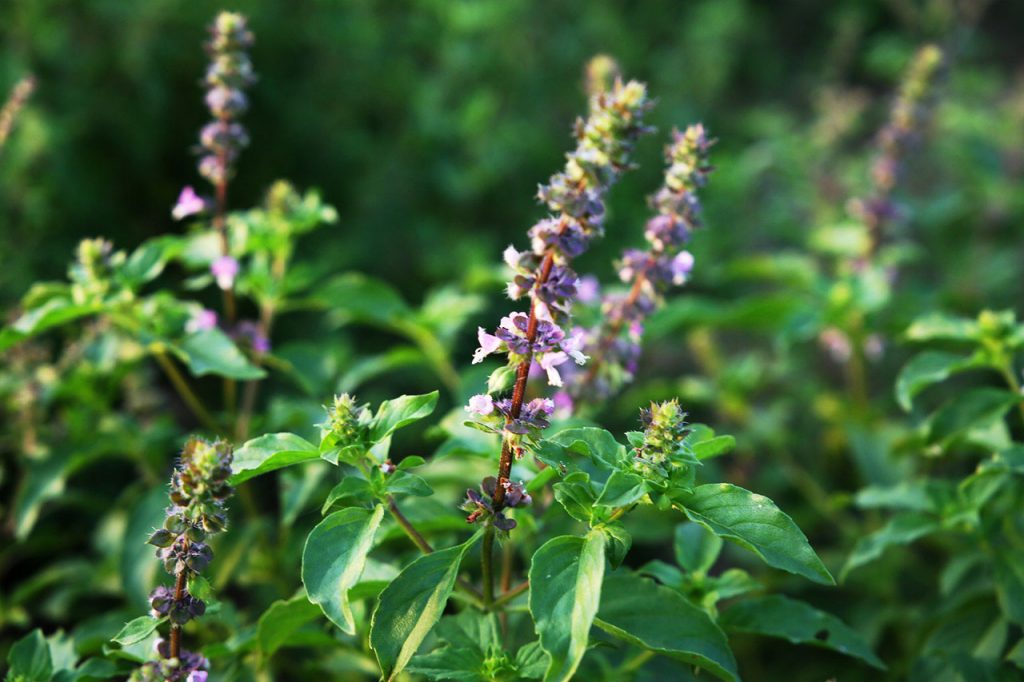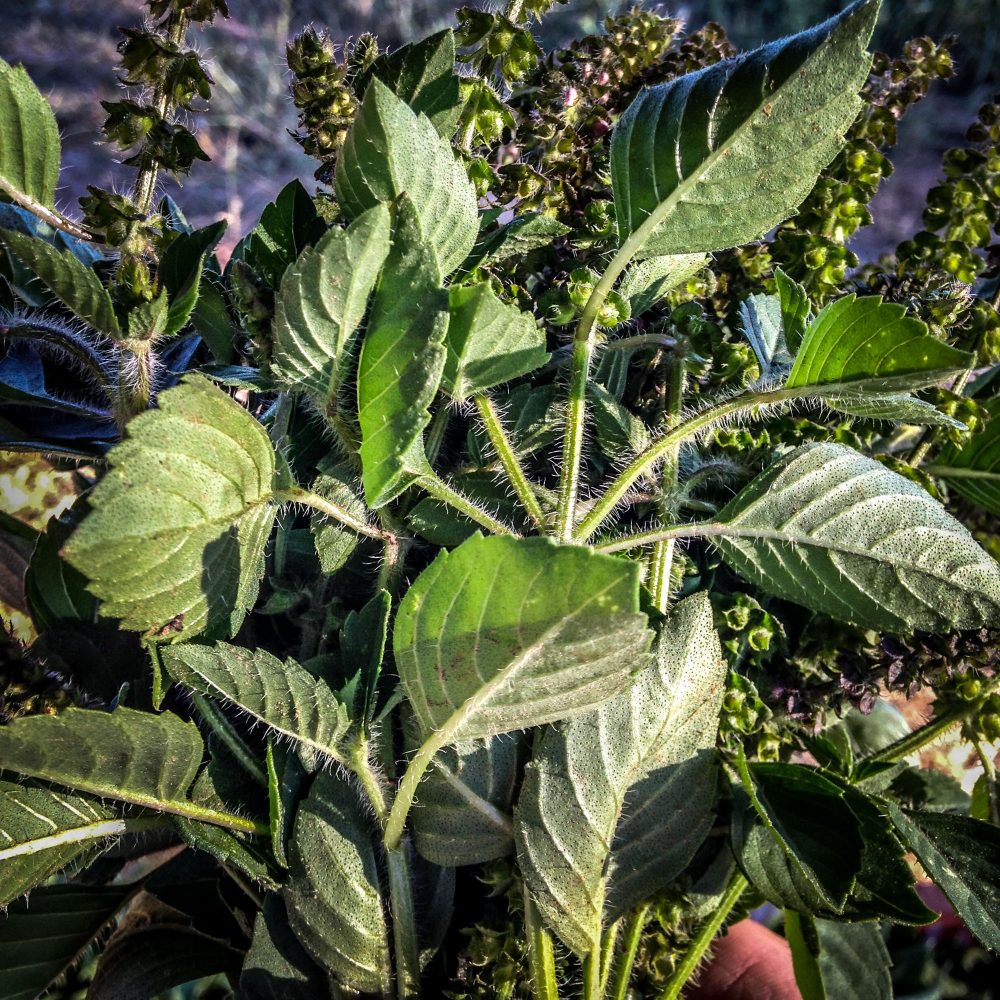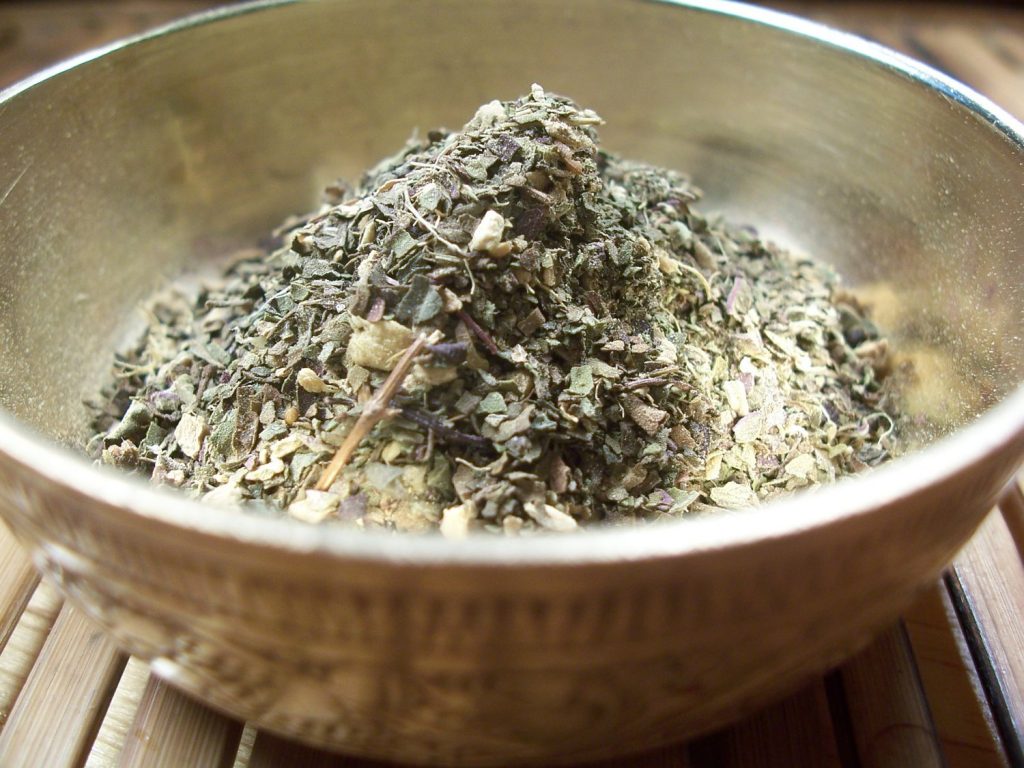Herban Love with Goldthread Herbs | Tulsi


Tulsi (Ocimum spp.);
Family: Labiatae
Taste: Pungent, Bitter
Temperature: Heating
Moisture: Drying overall
Herbal Actions: Expectorant, Diaphoretic, Nervine, Carminative, Febrifuge, Anti-bacterial, Anti-septic, Anti-fungal. Rasayana.
Tulsi, which translates as “the incomparable one”, is among the most sacred herbs in all of Ayurvedic medicine. It is commonly grown in and around Hindu homes and holy places for its atmosphere-purifying effects. Tulsi has an important place within the daily rituals and holy celebrations performed by Hindus throughout the year. It is worshipped as an emanation of the goddess Lakshmi, the lover of Vishnu. Tulsi provides a beautiful example of how certain cultures remember that to worship nature and god is one in the same.
Therapeutically…
Tulsi has a long and impressive list of benefits extending throughout the body. It is considered to be a Rasayana or Rejuvenative, as defined by Ayurvedic medicine. This is a similar definition to the Western concept of Adaptogenic, which points to an herb’s ability to improve adaptation and functioning in an individual by optimization in virtually every body system. It is also defined as a Sattvic herb, increasing the qualities of clarity, tranquility, joy, and vitality according to traditional Ayurvedic philosophy. A member of the mint family, this special Basil is usually seen in three main varieties: Rama, Krishna, and Vana Tulsi. Each has special properties, yet all can be used interchangeably as well. In the West, Tulsi is known as “Holy Basil”, yet, if you were to ask someone from the Mediterranean they would undoubtedly consider Greek or Genovese Basil equally holy. The truth is that all basil is holy and all share certain properties in common.
One way to understand Tulsi’s unique attributes is to look at the energetic similarities common among members of this genus. For instance, like other basils, Tulsi is a carminative with aromatic pungency and a heating nature. Herbs with carminative properties act as an agent to reduce bloating and flatulence. This makes it an excellent digestive remedy for conditions characterized by low digestive fire, gas, bloating, damp stagnation and general sluggishness. It increases appetite, calms spasms and cramps and helps to normalize blood sugars and fats. In Ayurvedic physiology, it enhances the function of Samana and Apana Vata subdoshas and increases the activity of Pachaka Pitta. These are the energetic forces that orchestrate proper secretion, circulation, and peristalsis within the GI tract and combine to create healthy Agni (digestive fire). Robust digestive fire is essential for metabolizing the excess Kapha and Ama contained in the blood as seen in conditions such as hypercholesterolemia and diabetes. It has attracted a great deal of interest from Western bio-medicine lately as a treatment for lowering blood sugar in diabetes. It has shown great promise in mild to moderate cases and is a likely to figure prominently as a treatment for this current epidemic.

Tulsi’s warming and stimulating nature is also very beneficial for the respiratory system. It is very effective at clearing excess mucous and congestion from the lungs caused by dampness and constriction. It can be used for acute or chronic bronchitis, rhinitis, respiratory allergies, coughs, and asthma. It is most suitable when respiratory conditions are characterized by excess cold and damp as opposed to dryness and heat. When conditions are characterized by dryness and irritation it is best to combine Tulsi with cooling and moistening herbs such as Shatavari and Licorice.
Tulsi has the special ability, or Prabhava in Ayurvedic language, to lower fevers regardless of their origin. It benefits fevers of an acute or chronic nature, improving the manifestation as well as the underlying causes. This function is a common attribute of mint family plants. Their energetic nature is to warm and stimulate the core and circulate energy towards the periphery. This opens the pores and vents the excess heat of fever. This diaphoretic property is also beneficial in a variety of eruptive skin issues characterized by itch and irritation. Tulsi’s traditional use for fever and infectious disease has been confirmed by western science, as they have shown it to be a broad-spectrum immune stimulant. Drinking a cup or two of hot Tulsi tea during the cold and flu season can be a useful addition to a preventative healthcare regimen.
Another target of Tulsi’s unique attributes is the nervous system. It would be classified as a calmative, rejuvenating nervine according to traditional Western herbalism. It is used for clarifying awareness and heightening mental acuity. It reduces overall tension in the nervous system and allows the Prana Vata to circulate freely. This is the maestro of Vata energy that orchestrates nerve current in the brain and throughout the body. Prana Vata governs and harmonizes the interface where we receive and interpret reality and how that is translated into physiological reality. Tulsi smooths and stimulates the flow of Prana within the nervous system resulting in crisper mental functioning, increased energy, and a calmer disposition.
Tulsi also has a general tonic effect upon the heart by way of its circulatory enhancement and calmative properties. While its high antioxidant and flavonoid content strengthens the vessels and increases their elasticity. Its pungency helps the body to dissolve and metabolize thick Kapha cholesterol and lipid material in the blood allowing the heart to work less to circulate it around the body. This also results in a mild but persistent hypotensive effect, especially when combined with other herbs in formulation.
Ways to incorporate Tulsi into your diet:
Preparation & Dosage:
- Infusion of dried leaves, 1-9g per day
- Tincture of fresh or dried plant, 5-15ml per day
- Fresh juice preparation, Powdered herb, Medicated Ghee, Honey infusion
 Introduce Tulsi to your diet with Goldthread Herbs and the Tulsi Clarity tonic.
Introduce Tulsi to your diet with Goldthread Herbs and the Tulsi Clarity tonic.
Suggested Herbal Combinations:
- w/ Fennel, Ginger, Cardamom, Rose, for digestive sluggishness and flatulence.
- w/ Passionflower and Lemon Balm for calmative effects.
- w/ Rosemary and Gotu Kola for promoting clarity of thinking.
- w/ Osha and White Pine for cold damp coughs.
- w/ Elder flower and Peppermint for fever.
- w/ Ashwaganda and Licorice for overall tonification.
- w/ Hawthorn, Linden, and Arjuna for hypertension & hypercholesterolemia.
Externally, Tulsi is equally versatile in its function. It can be made into a poultice for fungal and bacterial infections and to draw out boils. The herb can treat insect bites and is an effective repellant when applied as a spray or ointment. The fresh juice is effective for irritated or inflamed, and itching eyes. The tea or juice can also protect the mouth, gums, and teeth from bacteria, caries, and ulcerated conditions.
The essential oil can be diluted in a 1% solution of sesame oil and applied to the chest in bronchial conditions. Likewise, the oil can be diffused for colds flus and respiratory conditions such as asthma, and to stimulate appetite.

Potential Side Effects and Cautions: Tulsi is contraindicated in High Pitta conditions unless combined with other herbs. The Pitta dosha controls digestion, metabolism, and energy production. An excess in Pitta can result in an uncomfortable feeling of heat, irritability, heartburn, and more. Fever is the one exception here due to its Prabhava.
Propagation: Tulsi is usually cultivated annually from seed, although it can also be propagated from tip or root cuttings. The seeds have a very reliable and high rate of germination. They should be started in the greenhouse about six weeks before planting in northern locations and potted up once they have their true leaves. Sow Tulsi seeds just under the surface of the soil and press in firmly. Keep Tulsi seed watered and warm until germination, which occurs within 1 to 2 weeks.
Planting & Cultivation: Tulsi prefers full sun, warm temperatures, rich soil, and plenty of water. Thin or transplant to 1 to 2 feet apart. Tulsi does well in pots or window boxes and is traditionally grown for good luck near the front door of the house. Tulsi may grow to a meter or more in height and be ready for harvest in a few months. In warm climates an individual plant may live for a decade or more.
Harvesting & Processing: Harvest Tulsi when the plant is 12-14 inches tall, usually by mid-summer. Harvest no more than 40-60% of the plant and it will continue to grow, providing you with a second or third harvest. It is also useful to pinch off and dry the flowers as the plant is growing in order to send most of the energy into the leaves for a higher volume of plant material. Harvest leaves in the mid-morning, after the sun has dried the dew but before the heat of the day has set in. Herbs like Tulsi have a stronger flavor if harvested earlier in the day, before the sun has the opportunity to dry out some of the volatile oils. Post-harvest one can rinse the leaves with cold water, but only if they are dirty as this can degrade the quality of the essential oils.
Tulsi dries well in the drying room at a temperature of 90 degrees or so in just a few days. Rama is the easiest to garble as the stems are quite soft, while the Krishna and Vana are a bit woodier. Store dried Tulsi in a cool dry environment and it will typically last a year or more, although the sooner it is used the higher the content of essential oil and thus better effects.








